Caviar has long been synonymous with luxury, indulgence, and culinary sophistication. For many, it evokes images of opulent soirées and exclusive restaurants. Yet, beyond its reputation as a status symbol, caviar is a delicate gastronomic delight with nuanced flavors and textures that deserve appreciation. If you’re new to this gourmet treasure, understanding how to store, serve, and savor caviar is essential to fully enjoying its exquisite qualities. This beginner’s guide will walk you through everything you need to know.
Understanding Caviar
Caviar is the salted roe of sturgeon fish, harvested primarily from the Caspian and Black Sea regions, though farmed varieties are now widely available globally. Its taste can range from mildly nutty to briny and complex, depending on the sturgeon species, the water in which it was raised, and how it was processed. Beluga, Osetra, and Sevruga are the three most prestigious types of sturgeon caviar, each distinguished by its size, texture, and flavor.
For beginners, the first step in enjoying caviar is developing an awareness of its subtle differences. Beluga, known for its large, soft eggs, offers a creamy texture and delicate taste. Osetra has medium-sized eggs with a slightly firmer bite and nutty undertones, while Sevruga boasts small, dark eggs with a more pronounced briny flavor. While the price and prestige vary, the enjoyment of caviar depends more on technique and experience than on cost alone.
Storage: Preserving Freshness
Caviar is highly perishable, and proper storage is crucial to maintaining its texture, flavor, and aroma. Fresh caviar should always be kept cold, ideally between 28°F and 32°F (-2°C to 0°C). The refrigerator is typically the best storage option, preferably on the coldest shelf at the back, away from door openings where temperature fluctuations occur.
Caviar should remain in its original, unopened container until ready to serve. Once opened, it should be consumed within 24 to 48 hours. Always use a non-metallic spoon—mother-of-pearl, bone, or even plastic—to avoid altering the delicate taste. Metal utensils, especially silver, can react with the caviar, imparting a metallic or bitter note that diminishes the experience.
For longer-term storage, many gourmet caviar providers offer pasteurized or frozen options. Pasteurized caviar can last up to a month unopened but may have a slightly different texture, while freezing can preserve caviar for several months if done carefully. When freezing, ensure the caviar is sealed in an airtight container and thaw slowly in the refrigerator to prevent ice crystals from damaging the eggs.
Serving: Elevating the Experience
The ritual of serving caviar is as important as eating it. Traditionally, caviar is served chilled, often on a bed of crushed ice to maintain its optimal temperature. The presentation should highlight the visual appeal of the eggs—small, glossy, and uniform in appearance. The Caviar Club recommends serving caviar in a bowl nested within a larger bowl of ice to keep the eggs at the ideal temperature, ensuring they remain fresh and flavorful.
Accompaniments are optional but can enhance the tasting experience. Classic garnishes include blinis (small, light pancakes), toast points, and lightly buttered crackers. Some prefer subtle touches like finely chopped hard-boiled egg, crème fraîche, or a hint of chives, which complement the caviar without overpowering its flavor. Avoid strong or acidic condiments such as lemon juice or vinegar, which can mask the delicate nuances of the roe.
Beverage pairing can further elevate the experience. Champagne or dry sparkling wine is a traditional choice, with its crisp acidity balancing the rich, briny taste of the caviar. Vodka, chilled and pure, is another classic pairing, especially in Eastern European traditions. Even lightly chilled white wine can work well, particularly varieties with a mineral edge and subtle fruit notes.
When serving, portion control matters. Caviar is intensely flavorful, and even small amounts are satisfying. Typically, one to two teaspoons per person are sufficient for tasting. Scoop gently to preserve the integrity of the eggs, and avoid pressing or crushing them against the side of the container.
Savoring: The Art of Enjoyment
Savoring caviar is about appreciating its texture, flavor, and aroma. Start by observing the eggs’ appearance—their size, sheen, and color can indicate quality. Take a moment to inhale the subtle scent, which should be fresh and briny, reminiscent of the sea, but never fishy or overly pungent.
When tasting, place a small amount on the back of your hand or directly on a blini. Allow the eggs to roll over your tongue, releasing their flavor gradually. The experience is not just about saltiness; caviar offers a delicate balance of umami, creaminess, and a slight nutty undertone, with a satisfying pop as the eggs burst. Swallow slowly, letting the flavor linger, and notice the interplay between texture and taste.
For beginners, it may take a few tastings to fully appreciate the subtleties. Don’t rush—caviar is meant to be enjoyed slowly, ideally in a relaxed setting. The goal is not to finish quickly but to explore the spectrum of flavors and textures that distinguish this gourmet delicacy.
Final Thoughts
Caviar may seem intimidating at first, but understanding its storage, serving, and savoring transforms it from an exotic luxury into a personal culinary adventure. With careful handling, mindful presentation, and a patient, appreciative approach, even beginners can experience the magic that has made caviar a symbol of refined taste for centuries.
Whether you are sampling a modest amount at home or indulging in a rare variety at a gourmet event, remember that the pleasure of caviar lies not just in consumption but in the ritual—observing, preparing, and savoring each precious pearl. By respecting its delicate nature, you unlock a sensory experience that is both timeless and uniquely personal, offering a taste of culinary artistry that few other foods can match.



